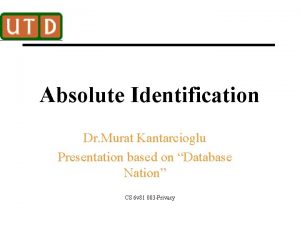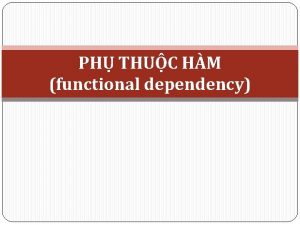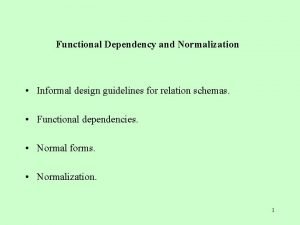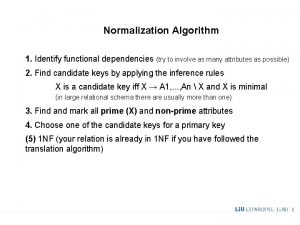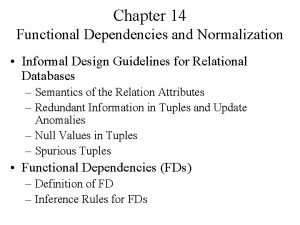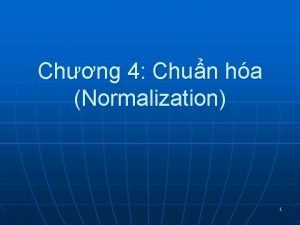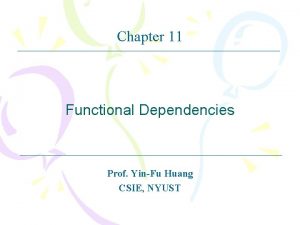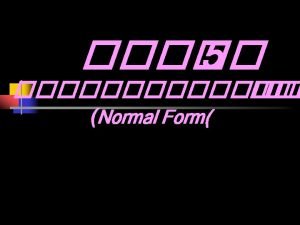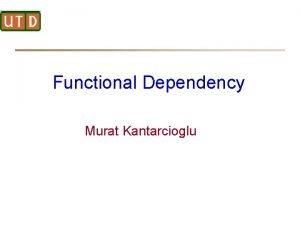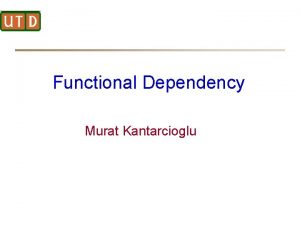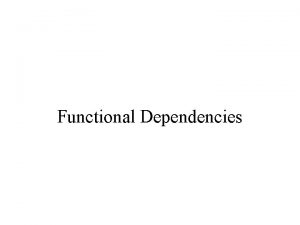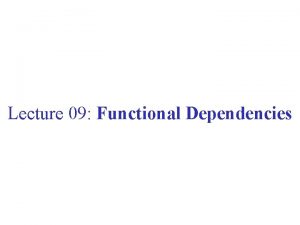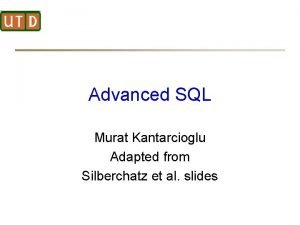Functional Dependency Murat Kantarcioglu Functional Dependencies Let R









- Slides: 9

Functional Dependency Murat Kantarcioglu

Functional Dependencies • Let R be a relation schema R and R • The functional dependency holds on R if and only if for any legal relations r(R), whenever any two tuples t 1 and t 2 of r agree on the attributes , they also agree on the attributes . That is, t 1[ ] = t 2 [ ]

Example • Example: Consider r(A, B ) with the following instance of r. A B 1 3 1 6 2 7 • On this instance, A B does NOT hold, but B A does hold.

Example A a 1 a 1 a 2 B b 1 b 2 b 1 C c 1 c 2 c 3 D d 1 d 2 d 1 • Does AB C hold? • Does ABC D hold ? • Does BC D hold?

Example SSN Last. Name First. Name City 11111 Smith John Richardson 22222 Li Peng Richardson 33333 Kant John Plano 44444 Smith Mark Plano • Does {ssn} {Last. Name} hold? • Does {ssn} {Last. Name, First. Name} hold ? • Does {Last. Name, First. Name} {City} hold? • Does {City} {First. Name} hold?

Procedure for Computing F+ F+=F repeat for each functional dependency f in F+ apply reflexivity and augmentation rules on f add the resulting functional dependencies to F + for each pair of functional dependencies f 1 and f 2 in F + if f 1 and f 2 can be combined using transitivity then add the resulting functional dependency to F + until F + does not change any further

Example • R = (A, B, C, G, H, I) F = { A B, A C, CG H, CG I, B H} • some members of F+ – A H • by transitivity from A B and B H – AG I • by augmenting A C with G, to get AG CG and then transitivity with CG I – CG HI • by augmenting CG I to infer CG CGI, and augmenting of CG H to infer CGI HI, and then transitivity

Closure of Attribute Sets • Given a set of attributes , define the closure of under F (denoted by +) as the set of attributes that are functionally determined by under F • Algorithm to compute +, the closure of under F result : = ; while (changes to result) do for each in F do begin if result then result : = result end

Example of Attribute Set Closure • R = (A, B, C, G, H, I) • F = {A B, A C , CG H, CG I, B H} • (AG)+ 1. result = AG 2. result = ABCG(A C and A B) 3. result = ABCGH (CG H and CG AGBC) 4. result = ABCGHI (CG I and CG AGBCH) • Is AG a candidate key? 1. Is AG a super key? 1. Does AG R? == Is (AG)+ R 2. Is any subset of AG a superkey? 1. Does A R? == Is (A)+ R 2. Does G R? == Is (G)+ R
 Murat kantarcioglu
Murat kantarcioglu Functional dependencies and normalization
Functional dependencies and normalization Informal design guidelines for relation schema
Informal design guidelines for relation schema Normalization example with solution
Normalization example with solution Functional dependencies شرح بالعربي
Functional dependencies شرح بالعربي Functional dependencies and normalization
Functional dependencies and normalization Irreducible set of functional dependencies
Irreducible set of functional dependencies John 10:22-28
John 10:22-28 Functional dependency calculator
Functional dependency calculator Let r=(a b c d) be a relation schema
Let r=(a b c d) be a relation schema
